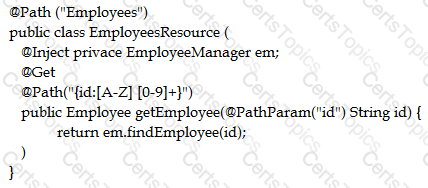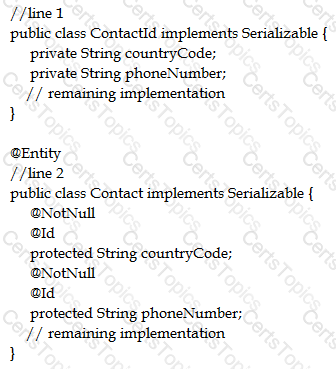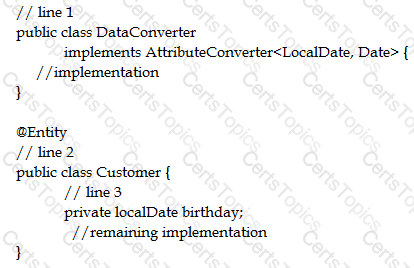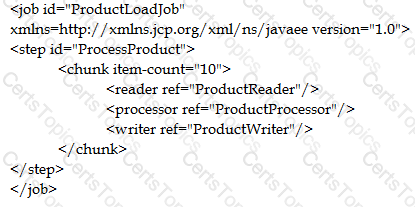Which two capabilities are provided by the Java Authentication and Authorization Services (JAAS) API? (Choose two.)
A user is performing a material return transaction against access stock in an Inventory organization; however, the user fails to select the Physical Material Return Required check box.
What happens?
Given the code sample:

And:

And:

And the next fragment from beans.xml:

And this injection point:
@Inject GenericMessenger messageHandler;
Which type would be injected at run time and referenced by the messageHandler variable?
Given the code fragment:

Which URL triggers the invocation of the getEmployee () method?
Which two features are provided by the JSTL Core library for a JSP? (Choose two.)
Your customer has a requirement across their 10 warehouses, each with different users. They would like that whenever a warehouse user logs in, their warehouse should get populated.
How will you achieve this?
A customer has one Business Unit, two Legal Entities, and each have eight warehouses (defined as Inventory Orgs). While trying to set up Cost Organizations for each of these Legal Entities you were unable to perform the mandatory step of assigning the Profit Center Business Unit for one set of eight Inventory Organizations; however, you could do it for the other set.
What is the reason for this?
How can you inject a target web service into an EJB?
How can you configure, in a portable way, the number of threads used by a ManagedExecutorService?
You are building the User Preferences page of an application. A user can change values, such as his or her name, password, address, company, and so on. These values are sent to a CDI backing bean via AJAX when the user tabs out of each field. However, the values must be retained in the CDI bean and stored in the database only when the user clicks the Save button.
Which two scopes will allow your CDI bean to retain its state while the user is interacting with the User Preferences page? (Choose two.)
Given the code fragments:

Which action completes this composite primary key implementation?
Your organization is using min-max planning to replenish stock and the planning parameters are set at item organization level with a default subinventory.
Item: A, Min Qty: 25, Max Qty: 150 and Current Level: 20
The item above is purchased from a supplier. Although there is subinventory on hand, the subinventory is below the minimum required level. This should trigger a Min-Max report entry, but the requisition is not generated. Why?
Given the code fragment:

How long does this cookie persist?
Given the code fragment:

How can you apply DateConverter to the birthday field?
How do you specify a default error page in your web.xml file?
During Cloud Inventory implementation your customer requires you to enable the Oracle Transactional Business Intelligence (OTBI) KPI to review the list of standard reports which is useful for their current business scenario. When navigating to reports and analytics, the warehouse dashboard doesn’t show any KPI watchlist.
Identify two causes. (Choose two.)
Which code snippet indicates that the page you are designing is capable of handling errors?
How can a servlet indicate to the browser that cookie data should be sent over a secure connection?
Given a JSL document describing a batch job:

How do you initiate a batch job?
Your class requires multiple resources defined, as shown in the following:

Which annotation do you use to group multiple @Resource declarations together for class-based injection, replacing
Your customer is a very large organization spanning across multiple countries. Their legal requirements, Human Resource Policies, and Functional Currencies for Ledger are different for each country. Your customer wants to maintain 10 different companies in the system.
Which combination meets this requirement?